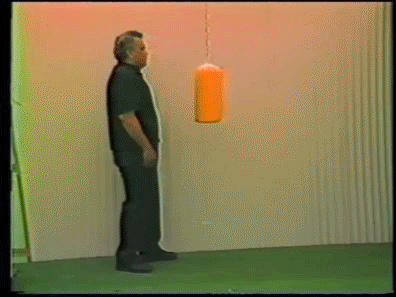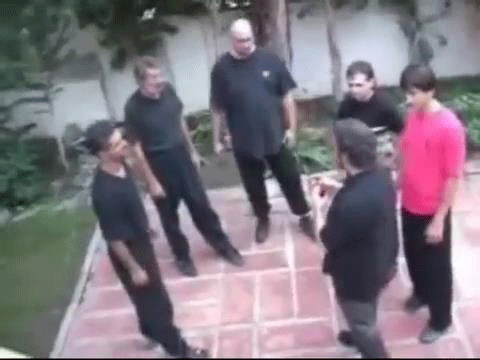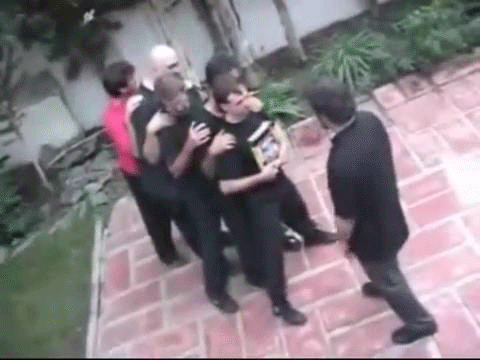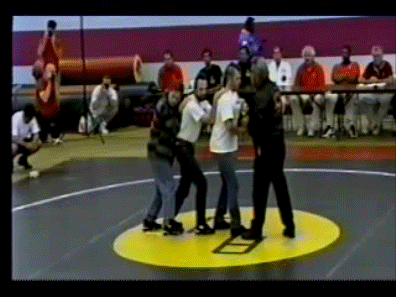Internal punch
Re: Internal punch
Neither one has is weight on his back leg at point of impact
Not that it makes any difference
Not that it makes any difference
Don't put power into the form let it naturally arise from the form
- wayne hansen
- Wuji
- Posts: 5832
- Joined: Mon Mar 16, 2009 1:52 pm
Re: Internal punch
[quote="MaartenSFS"]
I agree with what MaartenSFS said here"The power comes from rapidly dropping your centre of gravity whilst issuing some power into the ground, then, when, the ground sends back an equal force, re-directing that force into your opponent in the form of a wave." it looks as though he compresses his lead foot down into the ground to use the ground reaction force to create a wave through his body. Is this the higher level of small movement power generation in the internal arts such as Yiquan as in thes clips? https://www.youtube.com/watch?v=ShmPuxlehfs https://www.youtube.com/watch?v=EFH6gzxzgmw
The gentleman in the clip practices some combination of Indonesian and Chinese Internal styles.
Does anyone know which internal art uses this bio-mechanics power generation. To me it looks like it could be from Xing-yi, or Baji Quan.
I agree with what MaartenSFS said here"The power comes from rapidly dropping your centre of gravity whilst issuing some power into the ground, then, when, the ground sends back an equal force, re-directing that force into your opponent in the form of a wave." it looks as though he compresses his lead foot down into the ground to use the ground reaction force to create a wave through his body. Is this the higher level of small movement power generation in the internal arts such as Yiquan as in thes clips? https://www.youtube.com/watch?v=ShmPuxlehfs https://www.youtube.com/watch?v=EFH6gzxzgmw
The gentleman in the clip practices some combination of Indonesian and Chinese Internal styles.
Does anyone know which internal art uses this bio-mechanics power generation. To me it looks like it could be from Xing-yi, or Baji Quan.
Last edited by wingchun on Tue Nov 12, 2019 1:59 am, edited 1 time in total.
- wingchun
- Mingjing
- Posts: 86
- Joined: Tue Mar 29, 2011 7:51 am
Re: Internal punch
That's how I do it and it LOOKS like what I do, but there are multiple ways of issuing power like that, so it's hard to say exactly how he's doing it. I believe that my Master learned this from a Xinyiliuhequan master. When I learned Xingyiquan they definitely did not use this same method. Watch my swordsmanship video to see Zhenjin used from different angles. Most of the techniques I show are powered in this way. In the following travelling documentary I show a clip of me training on a mountain where you can see that I combined this power with Xingyiquan to create "Chuanquan" (penetrating fist). It is the second most important technique in my system. Unlike the demo in the video you posted, though, this drill is how you would use it in sparring.
https://m.youtube.com/watch?t=2s&v=aOCo-rfSs-s
https://m.youtube.com/watch?t=2s&v=aOCo-rfSs-s
Last edited by MaartenSFS on Tue Nov 12, 2019 4:04 am, edited 1 time in total.
-

MaartenSFS - Wuji
- Posts: 2355
- Joined: Thu Oct 03, 2013 8:22 pm
- Location: Cuenca, Spain
Re: Internal punch
wayne hansen wrote:Neither one has is weight on his back leg at point of impact
Not that it makes any difference
You may be right. However, the difference is keeping the weight on the back foot (rear hip) may create a harder punch as opposed to a push. As Demile mentions, Bruce's demonstration three inch punch (starting at finger tip distance), with weight on the lead foot at impact, created more of a push. BTW, this is consistent with a boxing trainer's statement that keeping more weight on the rear hip creates a harder straight or cross punch.
Here is a three inch punch bag exercise. Demile doesn't mention weight distribution, only that "raising of the heel propels the body forward:"

wingchun wrote:Can someone please explain what's going on here in regards to bio-mechanics and intent to be able to generate this kind of power?
https://www.youtube.com/watch?v=QkXSsHdGFkI
At 2:41 of the OP video, Al Colangelo's biomechanics' are similar to Demile's—suddenly collapse rear knee ("You should have a momentary feeling of falling.") while striking with the snapping of the wrist. With the one inch (starting at knuckle distance) or no inch punch, the heel stays closer to the ground:

-

marvin8 - Wuji
- Posts: 2917
- Joined: Mon Mar 02, 2009 8:30 pm
Re: Internal punch
In a sense, it really doesn't matter. If you can get the weight drop cleanly, it becomes easy to add a lot of variations as far as rotation, weight shift, front leg, back leg, double-hip action, etc. Some combinations seem to work marginally better than others, but at that point it's more a matter of nuance than substance. I expect different folks will find different variations that they gravitate to, but it's all based on that principle of the subtle weight drop. They can all be similarly impactful and explosive once you've worked out the variations (and practiced a bunch).
- Bhassler
- Great Old One
- Posts: 3554
- Joined: Tue May 13, 2008 8:05 pm
- Location: xxxxxxx
Re: Internal punch
+1。 After seeing it more closely it does differ from what I learned. Both hips drop evenly, the hip/waist torques and, if standing in a fighting stance, the back leg straightens/flexes slightly to anchor the structure to the ground. Not to say that what he is doing wrong, but I understand my method and how it works..
-

MaartenSFS - Wuji
- Posts: 2355
- Joined: Thu Oct 03, 2013 8:22 pm
- Location: Cuenca, Spain
Re: Internal punch
Bhassler wrote:In a sense, it really doesn't matter. If you can get the weight drop cleanly, it becomes easy to add a lot of variations as far as rotation, weight shift, front leg, back leg, double-hip action, etc. Some combinations seem to work marginally better than others, but at that point it's more a matter of nuance than substance. I expect different folks will find different variations that they gravitate to, but it's all based on that principle of the subtle weight drop. They can all be similarly impactful and explosive once you've worked out the variations (and practiced a bunch).
It depends whether you want to drop your opponent or just push them away (e.g., demo, parlor tricks, etc), as mentioned. Pushing punches is less powerful and may open one to counters.
Excerpt from "Bruce Lee's 1 and 3 Inch Power Punch:"
James Demile wrote:The method just described was used by Bruce Lee in his demonstrations and is referred to as a push punch. The opponent's reaction is shock from the blow and imbalance from the push. The main disadvantage in using the push punch is the tendency to overextend your energy towards the opponent. This opens you to counterattack.
The Floating Punch should only move a few inches past the point of contact. When the opponent is pushed, much of the energy transfer is lost. This reduces the shock of the blow. If the Floating Punch is properly done, the opponent will drop where he stands rather than fly backward.
Unless used for demonstrations, all techniques explained in this manual will drop the opponent with a short exploding Floating Punch. To minimize the tendency to overextend your energy, this manual emphasizes the right foot in a rear position.
-

marvin8 - Wuji
- Posts: 2917
- Joined: Mon Mar 02, 2009 8:30 pm
Re: Internal punch
johnwang wrote:
Not commenting on Colangelo's skills. However, Colangelo's participants are standing in parallel stance, Demile's participants are standing in staggered stance and the reactions are different (though different number of participants):


-

marvin8 - Wuji
- Posts: 2917
- Joined: Mon Mar 02, 2009 8:30 pm
Re: Internal punch
marvin8 wrote:Bhassler wrote:In a sense, it really doesn't matter. If you can get the weight drop cleanly, it becomes easy to add a lot of variations as far as rotation, weight shift, front leg, back leg, double-hip action, etc. Some combinations seem to work marginally better than others, but at that point it's more a matter of nuance than substance. I expect different folks will find different variations that they gravitate to, but it's all based on that principle of the subtle weight drop. They can all be similarly impactful and explosive once you've worked out the variations (and practiced a bunch).
It depends whether you want to drop your opponent or just push them away (e.g., demo, parlor tricks, etc), as mentioned. Pushing punches is less powerful and may open one to counters.
Excerpt from "Bruce Lee's 1 and 3 Inch Power Punch:"James Demile wrote:The method just described was used by Bruce Lee in his demonstrations and is referred to as a push punch. The opponent's reaction is shock from the blow and imbalance from the push. The main disadvantage in using the push punch is the tendency to overextend your energy towards the opponent. This opens you to counterattack.
The Floating Punch should only move a few inches past the point of contact. When the opponent is pushed, much of the energy transfer is lost. This reduces the shock of the blow. If the Floating Punch is properly done, the opponent will drop where he stands rather than fly backward.
Unless used for demonstrations, all techniques explained in this manual will drop the opponent with a short exploding Floating Punch. To minimize the tendency to overextend your energy, this manual emphasizes the right foot in a rear position.
Either can be done from any position or variation of the method-- one just has to practice it. I believe the key is in Mr. Demile's last sentence: "To minimize the tendency to overextend your energy, this manual emphasizes the right foot in a rear position." Even he's not saying that it can only be done way, but he's limiting it in his book/DVD/whatever to counter a common beginner mistake. This is a common teaching technique although, in my opinion, not a very good one. That's a different conversation, however.
- Bhassler
- Great Old One
- Posts: 3554
- Joined: Tue May 13, 2008 8:05 pm
- Location: xxxxxxx
Re: Internal punch
Bhassler wrote:marvin8 wrote:Bhassler wrote:In a sense, it really doesn't matter. If you can get the weight drop cleanly, it becomes easy to add a lot of variations as far as rotation, weight shift, front leg, back leg, double-hip action, etc. Some combinations seem to work marginally better than others, but at that point it's more a matter of nuance than substance. I expect different folks will find different variations that they gravitate to, but it's all based on that principle of the subtle weight drop. They can all be similarly impactful and explosive once you've worked out the variations (and practiced a bunch).
It depends whether you want to drop your opponent or just push them away (e.g., demo, parlor tricks, etc), as mentioned. Pushing punches is less powerful and may open one to counters.
Excerpt from "Bruce Lee's 1 and 3 Inch Power Punch:"James Demile wrote:The method just described was used by Bruce Lee in his demonstrations and is referred to as a push punch. The opponent's reaction is shock from the blow and imbalance from the push. The main disadvantage in using the push punch is the tendency to overextend your energy towards the opponent. This opens you to counterattack.
The Floating Punch should only move a few inches past the point of contact. When the opponent is pushed, much of the energy transfer is lost. This reduces the shock of the blow. If the Floating Punch is properly done, the opponent will drop where he stands rather than fly backward.
Unless used for demonstrations, all techniques explained in this manual will drop the opponent with a short exploding Floating Punch. To minimize the tendency to overextend your energy, this manual emphasizes the right foot in a rear position.
Either can be done from any position or variation of the method-- one just has to practice it. I believe the key is in Mr. Demile's last sentence: "To minimize the tendency to overextend your energy, this manual emphasizes the right foot in a rear position." Even he's not saying that it can only be done way, but he's limiting it in his book/DVD/whatever to counter a common beginner mistake. This is a common teaching technique although, in my opinion, not a very good one. That's a different conversation, however.
Not sure what or if you are arguing. Demile is saying there are two distinct punches: the push punch for demoes and Floating Punch for combat. Him and Bruce developed them together.
In the "Advanced Aikijujutsu" video clip and book, Demile says him and Bruce want to drop their opponent not push them away in combat. People may copy Bruce Lee's movie and demonstration moves without knowing Bruce would not use them in actual combat.
-

marvin8 - Wuji
- Posts: 2917
- Joined: Mon Mar 02, 2009 8:30 pm
Re: Internal punch
Contraction of the intercostals and paraspinal groups causing a rapid compression redirected through the arm, combined with a very short sinking into the hip/thigh area (kua), as well as explosive contraction in the legs and glutes = fa jing. This kind of force (and the degree demonstrated) is relatively common in traditional CMA. The gentleman in the clip seems to be partly depending on a rotation around his central axis (counter clockwise) and extension from his shoulder.
Last edited by kenneth fish on Tue Nov 12, 2019 7:36 pm, edited 1 time in total.
A casual stroll through the lunatic asylum shows that faith does not prove anything.
Friedrich Nietzsche
Friedrich Nietzsche
-

kenneth fish - Great Old One
- Posts: 2518
- Joined: Tue May 13, 2008 5:19 pm
Re: Internal punch
Bhassler wrote:marvin8 wrote:Bhassler wrote:In a sense, it really doesn't matter. If you can get the weight drop cleanly, it becomes easy to add a lot of variations as far as rotation, weight shift, front leg, back leg, double-hip action, etc. Some combinations seem to work marginally better than others, but at that point it's more a matter of nuance than substance. I expect different folks will find different variations that they gravitate to, but it's all based on that principle of the subtle weight drop. They can all be similarly impactful and explosive once you've worked out the variations (and practiced a bunch).
It depends whether you want to drop your opponent or just push them away (e.g., demo, parlor tricks, etc), as mentioned. Pushing punches is less powerful and may open one to counters.
Excerpt from "Bruce Lee's 1 and 3 Inch Power Punch:"James Demile wrote:The method just described was used by Bruce Lee in his demonstrations and is referred to as a push punch. The opponent's reaction is shock from the blow and imbalance from the push. The main disadvantage in using the push punch is the tendency to overextend your energy towards the opponent. This opens you to counterattack.
The Floating Punch should only move a few inches past the point of contact. When the opponent is pushed, much of the energy transfer is lost. This reduces the shock of the blow. If the Floating Punch is properly done, the opponent will drop where he stands rather than fly backward.
Unless used for demonstrations, all techniques explained in this manual will drop the opponent with a short exploding Floating Punch. To minimize the tendency to overextend your energy, this manual emphasizes the right foot in a rear position.
Either can be done from any position or variation of the method-- one just has to practice it. I believe the key is in Mr. Demile's last sentence: "To minimize the tendency to overextend your energy, this manual emphasizes the right foot in a rear position." Even he's not saying that it can only be done way, but he's limiting it in his book/DVD/whatever to counter a common beginner mistake. This is a common teaching technique although, in my opinion, not a very good one. That's a different conversation, however.
I had to leave before figuring out what you were saying. I'll try again.
That's not the key nor what Demile is saying. The purpose of the push punch is to dramatically push the participant away for the audience. "Tendency to overextend" is inherent in the push punch itself. It applies to anyone. It's not just a "common beginner mistake." Demile does not say for beginners In the prior statement: "The main disadvantage in using the push punch is the tendency to overextend your energy towards the opponent. This opens you to counterattack."
One cannot do "any position" or do the push punch and call it the Floating Punch. Per Demile, the Floating Punch (aka power punch) was taught to him by Bruce Lee. Bruce believed a fight should last 2 seconds. Bruce and Demile believe an opponent should be dropped not pushed away. Demile chose to write about the Floating Punch, effective for combat.
-

marvin8 - Wuji
- Posts: 2917
- Joined: Mon Mar 02, 2009 8:30 pm
Re: Internal punch
My point was merely that if someone understands the mechanics of this type of strike they can do a good damaging punch (not a push punch) from the front or back foot with either hand, it doesn't matter. It doesn't have to be a punch, either, it can be an elbow, or a pull, or a kao, or whatever. Since Demile more or less made up the term "floating punch", he can define it however he wants, so I won't argue the semantics of it.
- Bhassler
- Great Old One
- Posts: 3554
- Joined: Tue May 13, 2008 8:05 pm
- Location: xxxxxxx
Re: Internal punch
+1。There's no reason to overcomplicate it. Half of the masters I met in China could Fajin in a similar way. It's not uncommon or special, but may appear to be unique from a Western standpoint. It's an integral part of power generation in most CMA, particularly northern arts, but it is only a small part of what makes them effective.
-

MaartenSFS - Wuji
- Posts: 2355
- Joined: Thu Oct 03, 2013 8:22 pm
- Location: Cuenca, Spain
Re: Internal punch
Bhassler wrote:My point was merely that if someone understands the mechanics of this type of strike they can do a good damaging punch (not a push punch) from the front or back foot with either hand, it doesn't matter. It doesn't have to be a punch, either, it can be an elbow, or a pull, or a kao, or whatever.
Which goes back to your earlier statement:
Bhassler wrote:In a sense, it really doesn't matter. If you can get the weight drop cleanly ... They can all be similarly impactful and explosive once you've worked out the variations (and practiced a bunch).
That is what the OP is asking for "please explain the biomechanics." wingchun wants to "'understand the mechanics" and "variations that work."
Can you explain the "mechanics and variations that work" for a powerful strike other than "weight drop cleanly?"
-

marvin8 - Wuji
- Posts: 2917
- Joined: Mon Mar 02, 2009 8:30 pm
Return to Xingyiquan - Baguazhang - Taijiquan
Who is online
Users browsing this forum: johnwang and 62 guests

